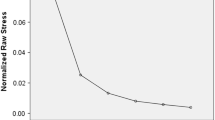Abstract
A frequent variety of typology is that which results when a given population is classified simultaneously by several criteria, the categories of each criterion being ordered in a sense common to all the criteria. Such simultaneous orderings automatically define a partial order typology.The empirical problem is to ascertain the dimensionality and the substantive meaning of the partial order. This is illustrated here by characterization of the Jewish population of Israel by the frequencies of use of a variety of drugs. The data analysis approach adopted is that of Partial Order Structuple (Scalogram) Analysis (POSA). The particular computer program used is POSAC (POSA with Base Coordinates).
The analysis revealed that it is possible to portray the distinct profiles (structuples) of the respondents according to drug use in a two-dimensional space, with a substantive regularity relating both to legal (pain relievers) and illegal drugs (marijuana, methadon). This space also serves as a basis for discriminant analysis for age as an external background variable.
Similar content being viewed by others
References
Amar, R. (1995). Multidimensional Partial Order Scalogram Analysis with Base Coordinates (MPOSAC). In J. J. Hox, G. J. Mellenbergh & P. G. Swanborn (eds), Facet Theory Analysis and Design, pp. 1–10. Zeist: SETOS.
Amar, R. & Toledano, S. (1994). Hudap Manual with Mathematics. Jerusalem: The Hebrew University of Jerusalem, Computing Center.
Brown, J. M. & Sime, J. D. (1982). Multidimensional scaling analysis of qualitative data. In E. Shepard & J. P. Watson (eds), Personal Meanings, pp. 71–90. New York: John Wiley & Sons.
Guttman, L. (1967). The development of nonmetric space analysis: A letter to Professor John Ross. Multivariate Behavioral Research, 2: 71–82.
Guttman, L. (1972). A partial-order scalogram classification of projective techniques. In K. Hammer, K. Salzinger, & S. Sutton (eds), Psychology, pp. 481–490. New York: John Wiley & Sons.
Guttman, L. & Bat-Miriam, M. (1961). A new approach to fingerprint analysis in population studies. In Proceedings of the Second International Congress of Human Genetics, Rome, pp. 1481–1483.
Levy, S. (1984). Partial orders of Israeli settlements by adjustive behavior. Israel Social Science Research, 2: 44–65.
Levy, S. (1985). Partial order analysis of crime indicators. Social Indicators Research, 16: 195–199.
Levy, S. (1991). Discriminant analysis of works of art among school students. In R. Gutierrez & M. J. Valderrama (eds), Applied Stochastic models and Data Analysis, pp. 409–432. Singapore: World Scientific.
Levy, S. (ed.) (1994). Louis Guttman on Theory and Methodology: Selected Writings, Aldershot, Hampshire: Dartmouth Publishing Co.
Levy, S. & Guttman, L. (1985). The partial order of severity of thyroid cancer with the prognosis of survival. In J. F. Marcotorchino, J. M. Proth & J. Janssen (eds), Data Analysis in Real Life Environment: Ins and Outs of Solving Problems, pp. 111–119. Amsterdam: Elsevier Science Publisher B. V. (North Holland).
Levy, S. & Guttman, L. (1987). Partial order classification of micro-computers. In J. Janssen, F. Marcotorchino, & J. M. Proth (eds), Data Analysis, pp. 255–268. New York: Plenum Press.
Lingoes, J. C. (1968). The multivariate analysis of qualitative data. Multivariate Behavioral Research 3: 61–94. Also in J. C. Lingoes, E. E. Roskam, & I. Borg (eds), Geometric Representations of Relational Data, pp. 575–608. Ann Arbor, Mathesis Press, 1979.
Lipshitz, G. (1986). A spatial typology of Israel on basis of partial order analysis. Geographical Analysis 18: 324–342.
Shye, S. (1985). Multiple Scaling. Amsterdam: North Holland.
Shye, S. and Amar, R. (1985). Partial order scalogram analysis by base coordinates and lattice mapping of the items by their scalogram roles. In D. Canter, (ed.) Facet Theory; Approaches to Social Research, pp. 277–298. New York: Springer Verlag.
Yalan, et al. (1972). The Modernization of Traditional Agricultural Villages. Rehovot, Israel: Settlement Study Center.
Zvulun, E. (1978). Multidimensional Scalogram Analysis: The method and its application. In S. Shye, (ed.) Theory Construction and Data Analysis in the Behavioral Sciences, pp. 237–264. San Francisco: Jossey Bass.
Author information
Authors and Affiliations
Rights and permissions
About this article
Cite this article
Levy, S. A Typology of Partial-Order: The Case of Drug Use in Israel. Quality & Quantity 32, 1–13 (1998). https://doi.org/10.1023/A:1004229124947
Issue Date:
DOI: https://doi.org/10.1023/A:1004229124947




